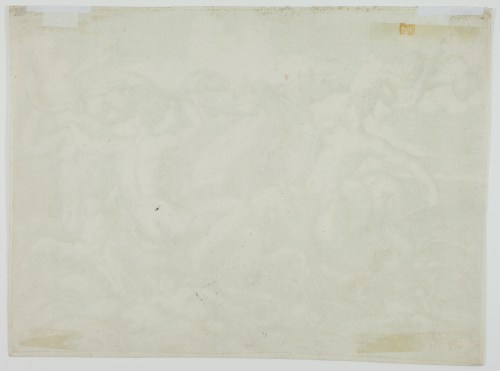Angelo FALCONETTO: Sirens, Naiads and Tritons - c. 1563
Price: 17 000 €
Etching, 230 x 312 mm. Bartsch 17, “premières épreuves” [early impressions].
Rare impression from 1st state (of 2) before Anglo falco’s signature bottom left.
Very fine impression printed on laid paper. Generally in excellent condition. A tiny stain above the left angel, a pale stain above the horses.
"These pieces are very difficult to find" wrote Bartsch about the engravings that he attributed to a certain "Angelo Falcone". The signature Anglo falco is nowadays read as that of the Verona painter and engraver Angelo Falconetto. Falconetto's prints are rare. The impressions of Mermaids, Naiads and Tritons are often printed in a dry and uneven manner. Our print is on the contrary well contrasted.
Bartsch notes that "this print is engraved according to a design attributed to Parmesan." (translated by us) Catherine Jenkins indeed underlines the influence of Parmigianino in the "sinewy and languid" style of the sea creatures, but she thinks that “Falconetto may have derived this small, animated group of frolicking sea creatures from a lost frieze design that was painted in a palace or villa in the Veneto. Elements of the composition, particularly the putto and dolphins along the lower edge, evoke the frieze adorning the salone centrale at the Palazzo Moneta (1558-1563) in Belfiore near Verona, the overall decoration of which Vasari attributed to the Veronese sculptor Bartolomeo Ridolfi.”
Catherine Jenkins recalls that this type of marine procession “had its roots in the classical marine thiasoi carved on ancient Roman sarcophagi”. She specifically notes that “the present motif of the Nereid viewed from behind riding on the back of a sea centaur […] appears on a marine sarcophagus that was in the collection of Cardinal Andrea della Valle during the sixteenth century, which inspired many Renaissance artists.” (Nadine Orenstein et al.: The Renaissance of etching, 2019, cat no.82, pp. 178-179).
Bernard Barryte underlines the virtuosity with which Falconetto has treated a complex scene: “in spite of the complicated relationships established between the various types of bodies, the etching has about it an air of effortless grace - the draftmanship is fluid and refined, the work of a practiced hand at the service of a lively imagination.” (Bernard Barryte: Myth, allegory, and faith: the Kirk Edward Long collection of mannerist prints, 2015, cat no. 59, p. 404).




